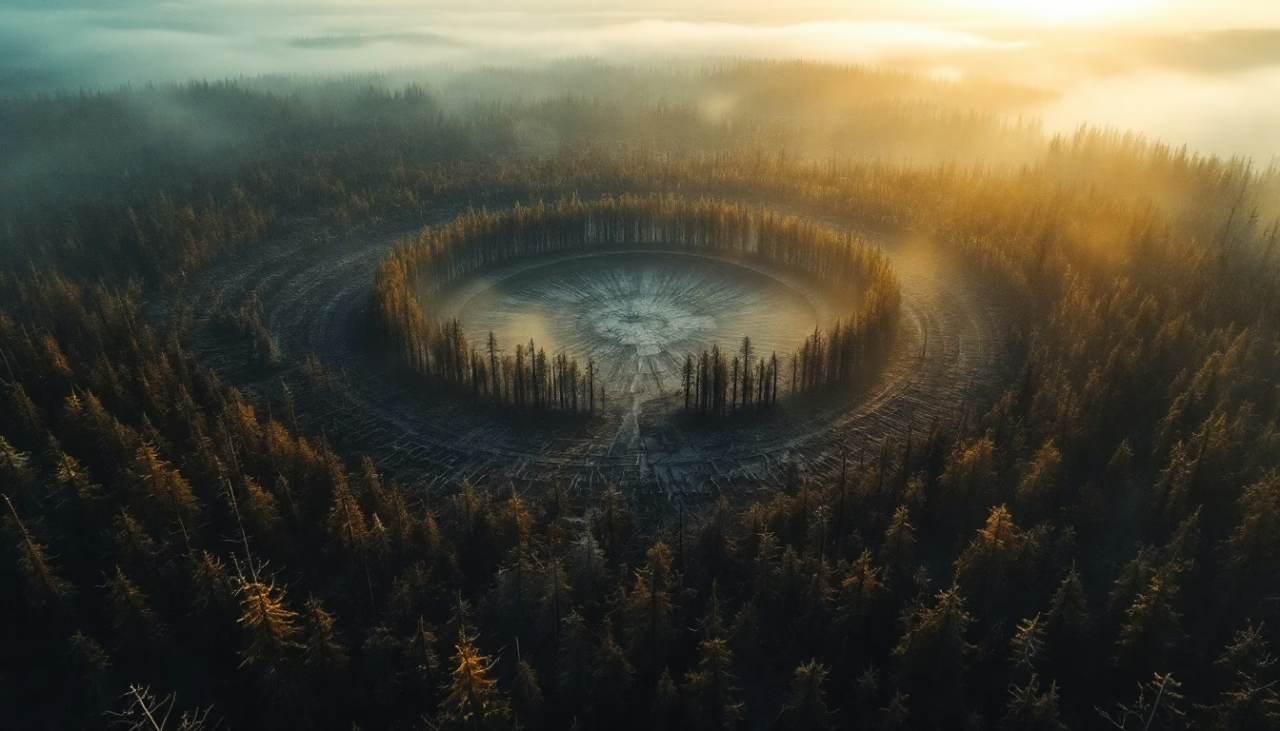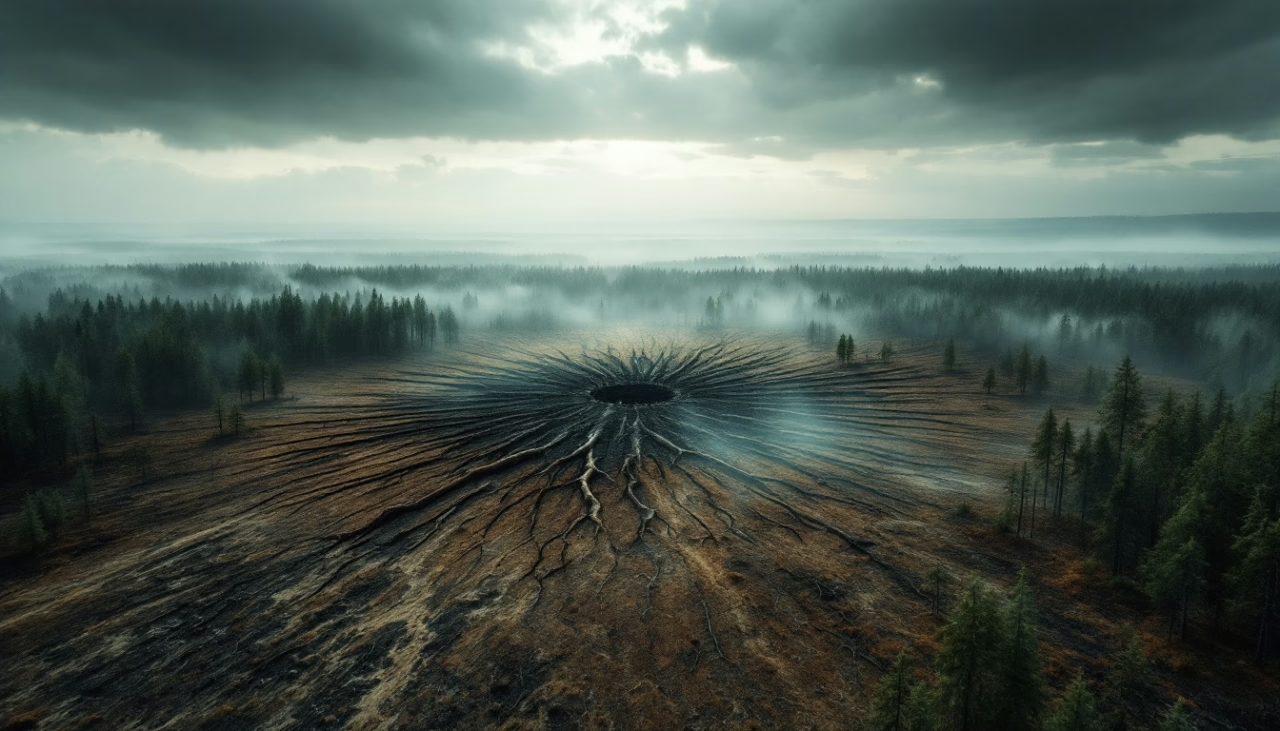The Tunguska Event: Mystery of the Tunguska Explosion

The Tunguska Explosion Mystery – At 7:17 AM on June 30, 1908, the Siberian sky erupted in flames.
Villagers near the Tunguska River witnessed a blinding light followed by a shock wave that flattened 80 million trees across 830 square miles.
No crater appeared. No meteorite fragments remained.
Scientists who finally reached the remote site discovered only a butterfly pattern of devastation radiating outward from an empty center.
What cosmic visitor had touched Earth that morning, delivering the force of a thousand Hiroshima bombs, then vanishing without a trace?
TL;DR
Hide- The 1908 Tunguska explosion flattened 80 million trees across 2,150 square kilometers in Siberia without leaving an impact crater.
- Scientific consensus suggests an airburst of a meteoroid or comet fragment 5-10 kilometers above Earth's surface.
- Eyewitnesses reported a "fiery pillar," thunderous booms, searing heat, and night skies that glowed for weeks afterward.
- Multiple theories exist including meteoroid airburst, comet fragment vaporization, natural gas explosion, and more controversial extraterrestrial explanations.
- The event's mysterious nature continues driving scientific investigation and has inspired planetary defense programs to monitor near-Earth objects.
What Caused the Tunguska Explosion? A Quiet Morning Shattered

On a tranquil June morning in 1908, the serene landscape of remote Siberia transformed into a scene of apocalyptic devastation when a mysterious explosion shattered the forest silence and flattened over 80 million trees across 830 square miles.
Indigenous Evenki witnesses described seeing a “fiery pillar” streak across the sky followed by a deafening blast that knocked people unconscious and burned their clothes, with some claiming the ground shook violently while the sky split open with blinding light.
The resulting destruction, documented by later scientific expeditions, revealed a curious pattern of devastation: trees toppled radially outward from the epicenter like fallen matchsticks, yet strangely, no impact crater was ever found in the Siberian wilderness.
Eyewitness Accounts from the Siberian Forest
Eyewitness accounts from indigenous Evenki people and Russian settlers describe a morning of unprecedented terror when an explosion ripped through the Siberian taiga on June 30, 1908.
Villagers reported hearing thunderous booms that echoed for hundreds of kilometers, followed by searing heat and a shockwave powerful enough to knock people off their feet and shatter windows in trading posts over 60 kilometers from the epicenter.
The night skies following the cataclysm glowed with an eerie luminescence visible across Europe and Asia, with one herder recounting how “the sky split in two” before a blinding flash turned darkness to light, leaving thousands of square kilometers of forest flattened in its wake.
Stories from nearby villages and reindeer herders
While villagers slept in their modest homes scattered across the remote Siberian landscape, a morning of extraordinary terror was about to unfold.
Local folklore preserved the survivor accounts describing the sky splitting open and transforming reindeer migration patterns forever.
The cultural impact lingered for generations, with indigenous communities documenting profound environmental changes that altered their traditional hunting territories and spiritual relationship with the land.
The sound, shockwave, and glowing skies
The physical manifestation of the Tunguska event extended far beyond cultural memory, producing atmospheric and acoustic phenomena that reverberated across thousands of square kilometers.
Seismic stations recorded shockwave measurements comparable to a 5.0 magnitude earthquake, while peculiar glowing phenomena illuminated night skies across Europe for weeks.
The atmospheric impact left signature sound effects—described as “deafening thunder”—whose historical significance continues to intrigue scientists studying catastrophic celestial collisions.
Devastation in Remote Siberia
The Tunguska blast flattened approximately 80 million trees across 830 square miles of remote Siberian forest, creating a butterfly-shaped pattern of destruction visible decades later.
Scientists who finally reached the site in the 1920s discovered trees still standing at the epicenter but stripped of branches, while those farther away had been knocked down radially outward, suggesting an atmospheric explosion rather than ground impact.
The scorched vegetation, charred reindeer, and peculiar radiation effects reported by locals hinted at temperatures that momentarily exceeded thousands of degrees, yet paradoxically left no impact crater—one of the event’s most perplexing characteristics.
Area flattened and trees scorched for miles
Nearly every tree within a vast 830-square-mile area lay flattened in radial patterns emanating from ground zero, silent witnesses to an explosion that shattered the calm Siberian morning on June 30, 1908.
The flattened forest exhibited remarkable patterns of ecological impact throughout the blast zone:
- Trees pointing outward from the epicenter
- Central areas showing scorched earth and charred remains
- Outer regions with standing but stripped trees
Unusual patterns in the blast zone
Amid the catastrophic devastation surrounding the epicenter, scientists documented several unusual patterns that defied conventional explanations for natural disasters or typical meteorite impacts.
The spatial distribution of fallen trees—radially arranged from a central point—presented unexplained anomalies in their symmetric positioning.
Impact assessment studies revealed an astonishingly rapid ecological recovery, with forest regrowth occurring at rates remarkably faster than comparable disaster zones elsewhere.
Investigating the Aftermath
Despite the Tunguska event‘s unprecedented magnitude, the first scientific expedition to the site didn’t occur until 1927, nearly two decades after the explosion, largely due to Russia’s political upheaval and the remote location’s inaccessibility.
When mineralogist Leonid Kulik finally reached the area, his team documented a bizarre landscape of scorched earth and thousands of flattened trees radiating outward from the epicenter in a butterfly-wing pattern spanning 830 square miles.
Most puzzling to the investigators was the complete absence of an impact crater or meteorite fragments, suggesting that whatever caused the devastation had exploded above the ground, leaving behind only its destructive signature but no physical remnants.
The Long Delay Before the First Expedition
Despite the cataclysmic nature of the explosion that flattened approximately 80 million trees across 2,150 square kilometers of Siberian taiga, political turbulence—including World War I, the Russian Revolution, and the subsequent Civil War—rendered the remote Tunguska site inaccessible to scientific investigation for nearly two decades.
It wasn’t until 1927 that Soviet mineralogist Leonid Kulik, driven by persistent reports of an extraordinary event and theories about a possible meteorite impact, finally secured government funding to lead the first scientific expedition to the blast zone.
Trudging through mosquito-infested swamps and dense forest with limited equipment, Kulik’s team documented the vast radial pattern of fallen trees but, to their profound disappointment, discovered no impact crater or meteorite fragments, consequently beginning one of science’s most enduring mysteries.
Why it took 19 years to reach the site
Although the Tunguska explosion reverberated across Siberia with enough force to register on seismic equipment as far away as St. Petersburg, the expedition to investigate faced insurmountable challenges.
The 19-year delay stemmed from:
- Remote accessibility issues in Siberia’s unforgiving taiga
- Inadequate funding during tumultuous political climate
- Scientific skepticism about the event’s significance
World War I and the Russian Revolution further complicated exploration efforts, postponing scientific inquiry into this extraordinary phenomenon.
Leonid Kulik and the Soviet mission to Tunguska
Leonid Kulik, a mineralogist at the Soviet Academy of Sciences, emerged as the driving force that would finally break the nearly two-decade silence surrounding the Tunguska mystery.
Securing government funding in 1927, he led a remote expedition into Siberia’s wilderness, documenting flattened trees radiating outward for kilometers.
Though Kulik’s findings revealed no meteorite crater, his scientific legacy established the historical significance of Soviet exploration in understanding this extraordinary cosmic event.
What the Scientists Found—and Didn’t Find
The scientific expeditions to the Tunguska site yielded puzzling contradictions that challenged conventional impact theories.
Most striking was the conspicuous absence of an impact crater, despite the catastrophic force that had flattened approximately 80 million trees across 2,150 square kilometers.
Instead, researchers discovered magnetized soil samples and a radial pattern of charred vegetation extending outward from the epicenter, suggesting an explosive airburst rather than direct terrestrial contact.
Absence of an impact crater
Despite extensive searches conducted by multiple scientific expeditions, one of the most perplexing aspects of the Tunguska event remains the complete absence of an impact crater.
This anomaly challenges conventional impact phenomenon understanding, fueling scientific skepticism about terrestrial explanations.
Researchers have proposed several theories for this geological mystery:
- Airburst explosion before ground contact
- Non-solid extraterrestrial object (comet/gas)
- Alternative crater formation processes masked by time and terrain
Magnetized rocks and charred vegetation
Evidence from initial expeditions to the Tunguska site revealed a landscape transformed by extraordinary forces, with magnetized rocks and charred vegetation patterns telling a silent but compelling story about the event’s true nature.
Scientists documented unusual concentrations of magnetized minerals amid geological anomalies, while radiation patterns in the charred biomass suggested intense heat followed by remarkable ecological recovery—circumstances that continue to challenge conventional impact theories.
Leading Theories and Scientific Models
Scientists have proposed several competing explanations for the mysterious Tunguska devastation, with each theory attempting to account for the extensive forest damage, unusual atmospheric phenomena, and conspicuous absence of a crater.
The meteor airburst hypothesis suggests a stony asteroid exploded approximately 5-10 kilometers above Earth’s surface, creating a powerful shockwave without leaving substantial fragments, while the comet hypothesis attributes the event to a fragment of ice and dust that completely vaporized upon atmospheric entry.
Some researchers, noting the region’s unusual geology, have explored more terrestrial explanations, including the possibility that a massive natural gas explosion from beneath the Siberian soil could have created the observed pattern of destruction without extraterrestrial involvement.
Meteor Airburst Hypothesis
The most widely accepted explanation for the Tunguska event posits that a meteoroid, approximately 50-60 meters in diameter, exploded as an airburst at an altitude of 5-10 kilometers above Earth’s surface, releasing energy equivalent to 10-15 megatons of TNT.
This cataclysmic aerial detonation, occurring when the cosmic intruder encountered increasing atmospheric pressure, accounts for the absence of a crater despite the event’s extraordinary destructive power.
Tree fall patterns at the site provide compelling evidence for this hypothesis, as they radiate outward from a central point like spokes on a wheel, consistent with the downward-directed blast wave that would result from an overhead explosion rather than a ground impact.
How a space rock exploded mid-air
While hurtling through the void of space at approximately 33,500 miles per hour, the rocky visitor that would become known as the Tunguska impactor met its fiery end not on Earth’s surface, but within its atmosphere.
This cosmic event, shrouded in scientific intrigue, demonstrates how mid-air explosions can occur when space rocks enter our atmosphere:
- Atmospheric friction creates intense heat
- Tremendous pressure builds between the object’s leading edge and air molecules
- Internal structural failure occurs before ground impact
Supporting evidence from tree fall patterns
Fallen trees, radiating outward like spokes on a cosmic wheel, provided the first tangible evidence supporting the airburst hypothesis following the 1927 expedition led by Leonid Kulik.
Subsequent tree impact analysis revealed a butterfly-shaped blast zone geography, with trees near the epicenter standing upright but stripped bare.
Remote sensing techniques later confirmed these patterns, while ecological recovery patterns demonstrated nature’s resilience following catastrophic disturbance, offering insights into long-term environmental effects.
Comet Fragment Hypothesis
The comet fragment hypothesis presents a compelling alternative to the meteor airburst theory, suggesting the Tunguska devastation resulted from an icy celestial body rather than a rocky asteroid.
Scientists favoring this model point to several key characteristics of the event—including the unusual atmospheric phenomena reported across Europe following the explosion—that align with the behavior of a volatile, ice-rich object disintegrating in Earth’s atmosphere.
The conspicuous absence of substantial physical remnants, which continues to puzzle researchers despite numerous expeditions to the site, further supports the comet hypothesis, as an icy body would vaporize more completely than its rocky counterparts, leaving minimal debris for future generations to discover.
Arguments for an icy body over solid rock
Why would scientists favor a comet fragment rather than an asteroid as the culprit behind the Tunguska devastation? The celestial object characteristics point to an icy body rather than solid rock, based on atmospheric behavior during cosmic impact.
Cometary material would:
- Vaporize completely in the atmosphere, explaining the absence of fragments
- Generate the observed airburst pattern through rapid disintegration
- Account for the unusual night sky illumination reported across Europe
Difficulty in locating physical remnants
Scientists searching for tangible evidence of the Tunguska impactor have encountered persistent frustrations that challenge conventional impact investigation methods.
The remote location in Siberia’s dense taiga presents extraordinary search challenges, compounded by harsh environmental conditions that rapidly degrade evidence.
Historical context further complicates matters—the first dedicated scientific expeditions arrived nearly two decades after the event, when investigative techniques of the early 20th century proved inadequate for the task.
Natural Gas Explosion or Terrestrial Origin
Some scientists have proposed that the Tunguska devastation resulted from a massive natural gas explosion, suggesting that methane or other volatile compounds trapped beneath Siberia’s permafrost suddenly erupted through geological faults.
This terrestrial explanation draws on observations of the region’s marshy landscape and volcanic history, pointing to precedents of gas releases that, while typically smaller in scale, could theoretically reach catastrophic proportions under specific geological conditions.
However, critics highlight significant weaknesses in these theories, particularly the absence of any crater or disruption to the ground that would indicate an explosion originating from below the surface, and the failure to explain the atmospheric phenomena reported across Europe following the event.
The swamp gas or volcanic gas theories
When examining terrestrial explanations for the Tunguska event, perhaps none have garnered as much scientific scrutiny as the methane eruption hypothesis, which proposes that a massive release of natural gas from the Siberian soil triggered the cataclysmic explosion.
Critics of volcanic origins point to several contradictory findings:
- No volcanic activity detected in the region
- Absence of typical volcanic deposits
- Atmospheric phenomena inconsistent with gas explosions
These environmental impacts would differ markedly from observed evidence.
Geological arguments and weaknesses
Geological faults in the natural gas explosion theory emerge when examining the distinctive features of the Tunguska blast zone.
While initial impact theories considered methane release, geological evidence reveals no significant fault lines or volcanic structures capable of producing such catastrophic environmental consequences.
Scientific skepticism persists because the historical context of similar natural gas explosions shows fundamentally different patterns—typically leaving craters, residual heat signatures, and chemical traces that are conspicuously absent from Tunguska’s landscape.
Alternative Explanations and Fringe Ideas
Beyond mainstream scientific explanations, the Tunguska event has inspired several fringe theories ranging from exotic cosmic phenomena to extraterrestrial involvement.
Some speculate about a microscopic black hole or antimatter collision with Earth, while others suggest the catastrophe resulted from a malfunctioning alien spacecraft, its technology far beyond early 20th-century human comprehension.
Perhaps most intriguing is the notion that inventor Nikola Tesla‘s experiments with wireless energy transmission inadvertently caused the devastation, a theory fueled by Tesla’s own cryptic statements about developing a “death beam” during that era.
Black Hole or Antimatter Collision
Some physicists have proposed the extraordinary hypothesis that the Tunguska devastation resulted from either a microscopic black hole passing through Earth or the collision of matter with antimatter, phenomena that would release catastrophic energy without conventional explosive residue.
These speculative theories gained limited traction in scientific circles during the mid-20th century, particularly as researchers struggled to explain the explosion’s massive energy release coupled with the puzzling absence of an impact crater.
However, both explanations have been largely dismissed by mainstream science due to the lack of expected physical evidence—a black hole would have created detectable gravitational effects on its exit path through the planet, while antimatter collision would have produced distinctive and persistent radiation signatures not found at the site.
Speculative physics and particle annihilation
What exotic cosmic phenomena might explain the devastation that occurred over the Siberian wilderness in 1908? Theoretical physicists have proposed particle annihilation processes involving exotic matter encountering Earth’s atmosphere.
Quantum fluctuations, they suggest, could have triggered catastrophic energy release with profound theoretical implications for particle physics.
- Microscopic black hole passing through Earth
- Matter-antimatter annihilation event
- Collision with quantum string remnant
Science continues pursuing these extraordinary possibilities despite limited evidence.
Lack of lasting radiation or gravitational effects
Although theoretical models of black holes and antimatter collisions might explain the Tunguska blast’s immense power, these exotic explanations falter critically when confronted with the absence of residual radiation or gravitational anomalies at the impact site.
Modern radiation detection methods have conclusively shown no lingering signature, while gravitational anomalies analysis confirms the area experiences normal gravitational fields.
Long term environmental impact and health effects studies further undermine these fringe hypotheses, reinforcing the scientific consensus evolution toward more conventional explanations.
Alien Spacecraft Theories
Among the most persistent fringe explanations for the Tunguska event is the theory that an alien spacecraft crashed or discharged a weapon, leaving behind the massive destruction but curiously little physical evidence.
This hypothesis gained significant traction in the mid-20th century, particularly during the Cold War era when UFO interest peaked and the remote, mysterious nature of the explosion fueled speculation about extraterrestrial involvement.
Science fiction novels, films, and television programs have subsequently cemented the Tunguska event in popular imagination as potential evidence of alien visitation, demonstrating how cultural narratives can preserve scientifically unsupported theories long after more mundane explanations have been established by researchers.
The explosion as a crash or weapon discharge
Since mainstream scientific consensus points to natural causes for the Tunguska event, a persistent subset of theories has emerged suggesting extraterrestrial intervention, specifically that the explosion resulted from an alien spacecraft crash or weapons discharge.
These impact scenarios propose:
- A damaged extraterrestrial craft exploding during emergency landing
- Deliberate weapon speculation involving military-level technology testing
- Crash analysis suggesting controlled descent gone catastrophically wrong
Pop culture’s role in keeping this idea alive
While scientists continue to favor natural explanations for the Tunguska event, popular culture has enthusiastically embraced and perpetuated alien spacecraft theories through literature, film, television, and gaming—creating a parallel narrative that thrives despite its scientific shortcomings.
From X-Files episodes to Marvel comics, these fictional adaptations transformed fringe Tunguska theories into enduring conspiracy narratives, with media portrayals often prioritizing dramatic tension over factual accuracy.
Nikola Tesla’s Energy Beam Speculation
Among the more persistent fringe theories surrounding the Tunguska Event is the speculation that Nikola Tesla accidentally caused the explosion through experiments with his Wardenclyffe Tower‘s alleged wireless energy transmission capabilities.
This theory lacks substantive documentation or a credible timeline connecting Tesla’s New York experiments to the Siberian explosion, with proponents typically ignoring that the Wardenclyffe project had already faced financial failure by 1908.
The Tesla connection exemplifies how exceptional scientific figures often become posthumously associated with unexplained phenomena, transforming historical scientists into almost mythological figures capable of powers far beyond their actual achievements.
Connection to Wardenclyffe Tower myths
Despite the absence of scientific evidence linking Nikola Tesla to the Tunguska event, persistent myths have circulated for decades suggesting his experimental work at Wardenclyffe Tower could have triggered the massive explosion.
These conspiracy theories typically claim:
- Tesla’s energy transmission experiments went awry
- Wardenclyffe’s purported “death ray” capabilities were tested on Siberia
- Historical context of Tesla’s financial struggles motivated weapons development
Lack of credible timelines or documentation
Although enthusiasts of the Tesla-Tunguska connection have persisted in their claims for nearly a century, a critical examination reveals no credible documentation or coherent timeline linking Tesla’s experiments to the Siberian explosion.
Historical records contain significant archival gaps, presenting formidable research obstacles for investigators. The documentation challenges extend beyond mere coincidence, as timeline discrepancies consistently undermine attempts to establish Tesla’s theoretical involvement with any scientific rigor.
Modern Investigations and Renewed Interest
The mysterious Tunguska event has experienced renewed scientific scrutiny in recent decades, with researchers employing satellite imagery and sophisticated computer modeling to reconstruct the cataclysm’s dynamics.
Modern investigations have unearthed compelling microscopic evidence, including unusual soil compositions and anomalous tree ring patterns that preserve a temporal record of the ecological aftermath.
These twenty-first century scientific approaches, combining remote sensing technology with meticulous ground-level analysis, have transformed our understanding of this cosmic enigma from mere historical curiosity to an invaluable case study for planetary defense strategies.
Satellite Imagery and Advanced Modeling
Satellite imagery and computational modeling have transformed our understanding of the Tunguska event, revealing previously undetectable impact patterns and forest damage radiating outward from the blast epicenter.
Advanced atmospheric simulations now suggest the object was likely a stony asteroid approximately 50-80 meters in diameter that entered Earth’s atmosphere at 15-20 kilometers per second, creating a devastating airburst equivalent to 10-15 megatons of TNT.
These technological breakthroughs have enabled scientists to reconstruct, with unprecedented precision, the trajectory, composition, and explosive force of the cosmic visitor that momentarily turned a remote Siberian sky into an inferno brighter than the sun itself.
What modern technology has revealed
Modern investigations of the Tunguska impact site have been revolutionized by technological advances unavailable to early explorers who trudged through the Siberian wilderness with only basic tools at their disposal.
Satellite analysis and advanced simulations now provide data-driven insights through global scientific collaboration.
Modern technology has revealed:
- Precise mapping of fallen trees patterns
- Chemical anomalies in soil samples
- Evidence suggesting airburst rather than direct impact
Simulations of the blast’s atmospheric behavior
Pioneering computer simulations have transformed our understanding of the Tunguska event‘s atmospheric dynamics, moving scientific inquiry beyond physical evidence to sophisticated mathematical modeling of what occurred in the skies above Siberia that fateful morning.
These impact simulations recreate the complex blast dynamics, tracking atmospheric waves and energy dispersion patterns with unprecedented precision.
Modern shockwave modeling reveals how the explosion’s force propagated through the atmosphere, flattening trees across vast distances.
Soil, Tree Rings, and Microscopic Evidence
Modern soil analyses have revealed intriguing anomalies in the Tunguska blast zone, including unusual concentrations of micrometeorite residue and distinct carbon signatures that differ markedly from surrounding Siberian territories.
Tree ring studies of the surviving pines, some still standing as gnarled testimonies to the 1908 cataclysm, show dramatic growth pattern disruptions followed by decades of abnormal development.
These microscopic clues, invisible to early investigators yet eloquent under contemporary scientific scrutiny, have provided researchers with a time-capsule of evidence that continues to fuel debate about the precise nature of the cosmic intruder.
Micrometeorite residue and carbon anomalies
Delving into soil samples from the Tunguska impact zone, scientists have uncovered microscopic enigmas that continue to perplex researchers studying this cosmic mystery.
Micrometeorite analysis reveals unusual carbon isotopes suggesting extraterrestrial origins, while disrupting conventional geological implications.
Three key findings include:
- Anomalous spherules containing exotic metals
- Carbon particles with isotopic ratios inconsistent with terrestrial sources
- Chemical signatures in atmospheric residue that defy classification
Growth patterns in surviving trees
Numerous trees that withstood the devastating blast of the Tunguska event have yielded remarkable dendrochronological records, preserving in their rings a silent testimony to that fateful morning in June 1908.
Scientists studying tree growth patterns within the blast zone have documented extraordinary survival mechanisms and ecological recovery trends.
These resilience studies reveal how the forest gradually reclaimed dominance, offering valuable insights into how ecosystems respond to catastrophic disturbances.
Enduring Questions and Legacy
The Tunguska Event continues to captivate scientists and the public more than a century after its occurrence, standing as perhaps the most dramatic demonstration of cosmic vulnerability in modern history.
Its enduring mystery—the absence of a crater, the conflicting eyewitness accounts, and the challenge of definitively identifying the object—has transformed how researchers approach astronomical threats, catalyzing the development of planetary defense programs and near-Earth object monitoring systems.
Beyond scientific implications, the event has permeated cultural consciousness, inspiring countless works of science fiction, conspiracy theories, and profound philosophical questions about humanity’s place in a universe where catastrophe can arrive unannounced from the skies.
Why the Tunguska Event Still Fascinates
The Tunguska Event remains one of science’s most enduring mysteries largely due to its unprecedented scale—a blast 1,000 times more powerful than the Hiroshima bomb that flattened 80 million trees yet occurred in such remote Siberian wilderness that serious investigation couldn’t begin until decades after.
Questions persist about the precise nature of the cosmic body, whether asteroid or comet fragment, with ongoing debates about its composition, trajectory, and why no significant crater was formed despite the extraordinary devastation.
This scientific puzzle, coupled with the event’s almost mythological status as the largest impact event in recorded human history, continues to fascinate researchers and the public alike, serving as a sobering reminder of our planet’s vulnerability to cosmic threats.
The scale and isolation of the incident
Mystery shrouds the true magnitude of the Tunguska event, which continues to captivate researchers and laypeople alike more than a century after its occurrence.
The scale significance of this cosmic impact, magnified by its geographic isolation in Siberia’s dense taiga, created a perfect scientific conundrum.
- Environmental impact extended across 830 square miles of forest
- Cultural context includes indigenous Evenki testimonies rarely consulted initially
- Scientific attention arrived belatedly due to political turmoil
Unanswered details that keep curiosity alive
Why does the Tunguska event continue to captivate scientific imagination and public fascination more than a century after its occurrence?
The convergence of unexplained phenomena within its historical context creates an intellectual vacuum that researchers endeavor to fill. Its profound cultural impact resonates across generations, while scientific curiosity drives ongoing research into cosmic vulnerabilities.
The event’s mysterious nature—documented yet inexplicably powerful—represents humanity’s enduring quest to understand catastrophic anomalies.
How It Changed Scientific Thought
The Tunguska Event fundamentally transformed scientific approaches to cosmic threats, catalyzing the development of planetary defense strategies that would have seemed fanciful before 1908.
Scientists, jarred by the realization that Earth exists in a cosmic shooting gallery, redirected significant resources toward tracking and cataloging near-Earth objects with potentially catastrophic impact trajectories.
This newfound vigilance, born from a Siberian wilderness catastrophe, established the foundation for modern impact prediction systems and mitigation technologies designed to prevent future Tunguska-scale events from occurring in more densely populated regions.
Influence on planetary defense strategies
Although scientists initially struggled to comprehend the true nature of the Tunguska event, its catastrophic aftermath has profoundly shaped modern approaches to planetary defense strategies.
The Tunguska catastrophe catalyzed global collaboration on asteroid monitoring and impact mitigation systems, becoming the cornerstone of early warning protocols.
- Detection networks spanning continents
- International agreements on response protocols
- Investment in deflection technologies
Greater focus on near-Earth objects
Since obliterating over 80 million trees in a remote Siberian forest, the Tunguska event has transformed scientific focus toward near-Earth objects, pushing astronomers and planetary scientists to reconsider Earth’s vulnerability in the cosmic shooting gallery.
This catalytic disaster prompted unprecedented systematic monitoring of near-Earth threats, advanced asteroid detection technologies, and thorough planetary defense strategies against potentially catastrophic cosmic impacts from wayward space rocks.
Wrapping Up
The Tunguska tale, tantalizing and tremendous, transcends temporal boundaries and continues to challenge contemporary cosmic comprehension.
Scientists still search for definitive solutions while society contemplates our celestial vulnerability, poised precariously beneath potentially perilous skies.
This mysterious morning in Siberia, marked by massive destruction without explanation, remains a powerful parable of how, despite our profound progress in understanding the universe, fundamental forces can still bewilder our brightest minds.





